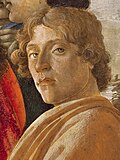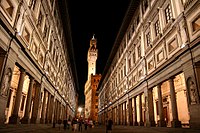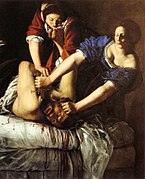File:Botticelli - Return of Judith.jpg

Original file (1,000 × 1,353 pixels, file size: 246 KB, MIME type: image/jpeg)
Captions
Captions
Summary
[edit]| Sandro Botticelli: The Return of Judith to Bethulia
|
||||||||||||||||||||||||||||||
|---|---|---|---|---|---|---|---|---|---|---|---|---|---|---|---|---|---|---|---|---|---|---|---|---|---|---|---|---|---|---|
| Artist |
|
|||||||||||||||||||||||||||||
| Title |
The Return of Judith to Bethulia label QS:Lit,"Ritorno di Giuditta a Betulia"
label QS:Lja,"ユディトのベツリアへの帰還"
label QS:Lfr,"Le Retour de Judith à Béthulie"
label QS:Lpl,"Powracająca Judyta"
label QS:Lhe,"שובה של יהודית לבתוליה"
label QS:Lnl,"The Return of Judith to Bethulia"
label QS:Lru,"Возвращение Юдифи в Ветулию"
label QS:Lde,"Judiths Rückkehr nach Bethulia"
label QS:Les,"Historias de Judit"
label QS:Len,"The Return of Judith to Bethulia"
label QS:Lbr,"Judit"
label QS:Lzh,"朱迪塔重歸貝圖利亞" |
|||||||||||||||||||||||||||||
| Object type |
painting |
|||||||||||||||||||||||||||||
| Genre |
religious art |
|||||||||||||||||||||||||||||
| Depicted people |
Judith |
|||||||||||||||||||||||||||||
| Date |
1470 |
|||||||||||||||||||||||||||||
| Medium |
tempera on panel |
|||||||||||||||||||||||||||||
| Dimensions |
height: 31 cm (12.2 in) dimensions QS:P2048,+31U174728 dimensions QS:P2049,+24U174728 |
|||||||||||||||||||||||||||||
| Collection |
institution QS:P195,Q51252 |
|||||||||||||||||||||||||||||
| Accession number |
00188555 (Uffizi Gallery) |
|||||||||||||||||||||||||||||
| References |
|
|||||||||||||||||||||||||||||
| Source/Photographer | Web Gallery Art | |||||||||||||||||||||||||||||
| Other versions |
|
|||||||||||||||||||||||||||||
Licensing
[edit]|
This is a faithful photographic reproduction of a two-dimensional, public domain work of art. The work of art itself is in the public domain for the following reason:
The official position taken by the Wikimedia Foundation is that "faithful reproductions of two-dimensional public domain works of art are public domain".
This photographic reproduction is therefore also considered to be in the public domain in the United States. In other jurisdictions, re-use of this content may be restricted; see Reuse of PD-Art photographs for details. | |||||
File history
Click on a date/time to view the file as it appeared at that time.
| Date/Time | Thumbnail | Dimensions | User | Comment | |
|---|---|---|---|---|---|
| current | 23:56, 6 August 2012 |  | 1,000 × 1,353 (246 KB) | VivaItalia1974 (talk | contribs) |
You cannot overwrite this file.
File usage on Commons
The following page uses this file:
File usage on other wikis
The following other wikis use this file:
- Usage on en.wikipedia.org
Metadata
This file contains additional information such as Exif metadata which may have been added by the digital camera, scanner, or software program used to create or digitize it. If the file has been modified from its original state, some details such as the timestamp may not fully reflect those of the original file. The timestamp is only as accurate as the clock in the camera, and it may be completely wrong.
| JPEG file comment | BOTTICELLI, Sandro
(b. 1445, Firenze, d. 1510, Firenze) The Return of Judith to Bethulia c. 1472 Oil on panel, 31 x 24 cm Galleria degli Uffizi, Florence The picture was probably created in pendant with The Discovery of the Murder of Holofernes; both of them are documented at the end of 16th century in Medicean collections, where entered as a gift received by Bianca Cappello, the second wife of Grand Duke Francesco I. The small scale of the paintings indicates that they were not intended as decoration for a piece of furniture. We know from contemporary inventories that paintings of similarly small dimensions were kept as precious objects in caskets or leather cases, to be admired at close proximity or shown to friends on special occasions. The miniature-like delicacy and detailed execution, conceived for close-range observation, leads to the supposition that the little panels were intended for just such a purpose. The Biblical tale of Judith, who slew Holofernes, the Assyrian king's commander-in-chief, because he represented a deadly threat for the Hebrews in Bethulia, was one of the favourite subjects of the Florentine Renaissance. Judith was considered the prototype of female strength, since she alone had summoned up the courage to murder the tyrant. In The Return of Judith to Bethulia, Botticelli shows us Judith together with Abra, her maid, the two of them striding out in a well-nigh furious manner. Abra is carrying Holofernes' severed head on her own head, while Judith has an olive branch in her hand as a symbol of peace, which she is bringing to the Hebrews. Botticelli has succeeded here in capturing both movement and stillness in a unique balance. Judith is pausing a moment in her striding forward to turn towards the observer, self-assured if not without a touch of melancholy, exactly as if she wished to present herself as the victor. <P> <TABLE ALIGN=LEFT CELLPADDING=5 BORDER=1 WIDTH=320 BGCOLOR="#99CCCC"> <TR VALIGN=MIDDLE><TD><IMG SRC="/support/gif/listen.gif" BORDER=0 VALIGN=MIDDLE> Suggested listening (streaming mp3, 17 minutes):<BR><A HREF="#" onClick="w=window.open ('/music1/17_cent/scarlatti_giuditta.html', 'newWin', 'scrollbars=yes,status=no,dependent=yes,screenX=0,screenY=0,width=350,height=350');w.opener=this;w.focus();return true"><B>Alessandro Scarlatti: La Giuditta, oratorio, Part I (excerpts)</B></A> </TD></TR></TABLE>
Author: BOTTICELLI, Sandro Title: The Return of Judith to Bethulia Time-line: 1451-1500 School: Italian Form: painting Type: religious |
|---|





